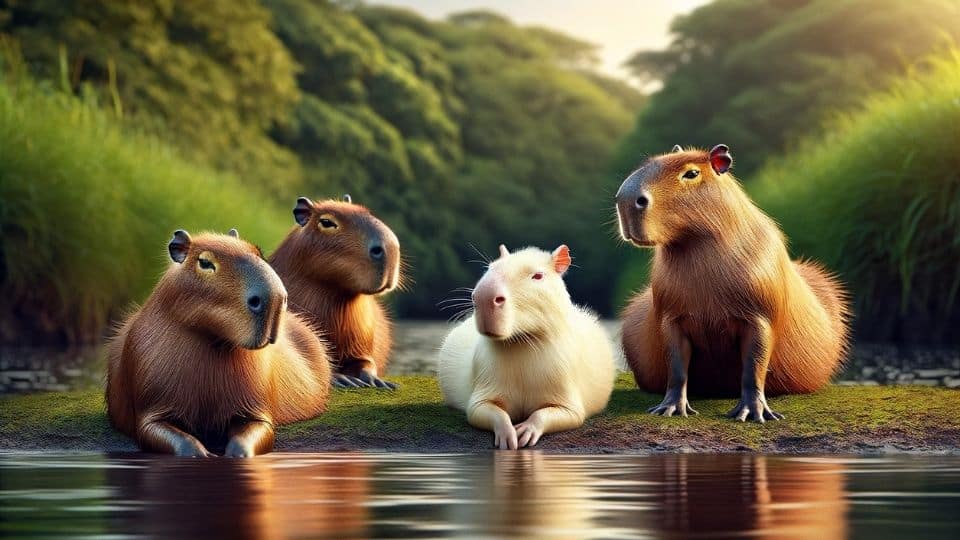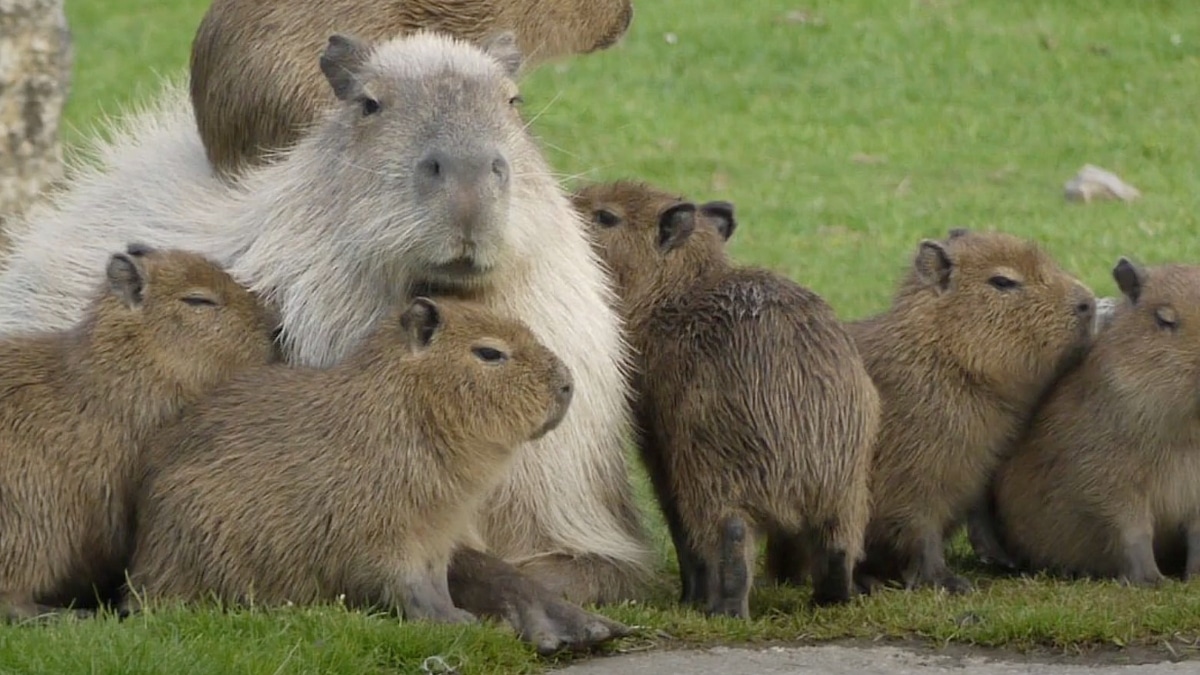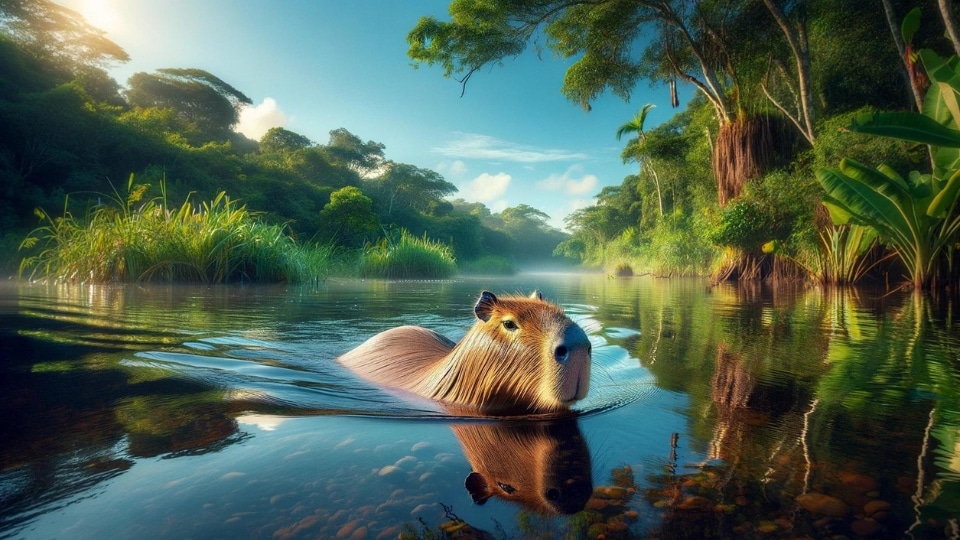Albino capybaras are indeed a reality, though they are a rare sight. A recent highlight in the world of these large rodents is the birth of an albino capybara at Ueno Zoological Gardens in Japan, marking a significant event for the species. Capybaras, known as the world’s largest rodents, are native to South America and are not commonly found in zoos, especially in albino form.
The Rarity of Albinism in Capybaras

Albinism in capybaras is a genetic mutation that affects melanin distribution, leading to a lack of pigmentation in the skin, fur, and eyes.
Contrary to some misconceptions, this condition is a result of genetic factors rather than natural selection, as the lack of camouflage can increase vulnerability to predators, posing a disadvantage in the wild.
Approximately 1% of the capybara population exhibits this rare trait.
These distinctive capybaras, sometimes referred to as “ghost” or “milk” capybaras due to their appearance, have white fur, pink eyes, and a unique ability to reflect light, making them a remarkable sight in their natural habitat.
Albino capybaras, while unique in appearance, share the same herbivorous dietary preferences as their typical counterparts, including a reliance on grasses and water plants.
Unique Challenges Faced by Albino Capybaras

Despite their striking appearance, albino capybaras face challenges.
Their poor vision, often a result of cloudy lenses or ocular disorders like cataracts, along with their heightened sensitivity to light and heat, calls for special care, such as access to cool shelters. rs such as cataracts.
A lack of pigmentation may also lead to lower vitamin D levels, potentially causing bone deformities if not managed with appropriate nutrition or UVB light exposure.
Bubbles A Famous Albino Capybara
In the wild, there have been documented cases of albino capybaras in Venezuela, with at least two instances of albinism in capybaras living near Maracaibo Lake.
The most famous albino capybara, Bubbles, resides at the Toronto Zoo and was discovered by accident at a farm outside of Toronto.
Albinism is often misunderstood, but it is essential to note that it is not a disease or a sign of an unhealthy animal. It is a genetic condition that affects only the pigmentation and, in some cases, vision.
Albino capybaras are just as capable and resilient as their pigmented counterparts, though they may require some special care due to their condition.
Temperament of Albino Capybaras and Normal Capybaras
Albino capybaras and their pigmented peers share similar temperaments. They exhibit complex social structures and communicate through a range of vocalizations and behaviors, irrespective of their coloration.
As semi-aquatic mammals, their affinity for water is a shared characteristic that unites them, regardless of pigmentation.Albino capybaras share many traits with their non-albino counterparts, including their generally calm demeanor.
This temperament has led to an interesting debate among enthusiasts and experts alike about the overall nature of capybaras and whether their friendly reputation holds in all situations.
Thought-Provoking Insights on Albino Capybaras

Genetic Rarity and Its Implications
The birth of an albino capybara is not just a genetic curiosity but also a catalyst for conservation discussions. It spotlights the genetic diversity within capybara populations and underscores the importance of genetics in species adaptation and survival.
The specialized care required by albino capybaras in the wild underscores the importance of human stewardship in the conservation of these unique animals. Albino capybaras are rare and fascinating. If you’re thinking about owning one in California, learn about the specific legal guidelines by visiting our article on capybara legality in California.
Conservation Efforts and Specialized Care
Albino capybaras in the wild face unique challenges that their pigmented counterparts do not.
Their survival and well-being can often depend on human intervention and specialized care.
This situation presents an opportunity for zoos, wildlife sanctuaries, and conservationists to develop targeted strategies to ensure the health and longevity of these rare animals.
It also highlights the importance of ethical considerations in the display and breeding of albino animals in captivity.
Beyond the White Coat
The existence of albino capybaras brings attention to the broader topic of albinism in the animal kingdom.
It’s a chance to educate the public on the complexities of this genetic condition, which affects not just the appearance but also the health and sensory abilities of the animals.
Dispelling myths and misconceptions about albinism is crucial for fostering a more informed and compassionate perspective towards animals with this condition.
Like their typically colored counterparts, albino capybaras share the same exceptional swimming abilities, a key aspect of their survival explored in detail in our article on capybara swimming.
The Ecological Role of Albino Capybaras
Albino capybaras, while rare, are part of the diverse tapestry of life within their ecosystems.
Their presence prompts us to consider the ecological role they play and how they interact with their environment.
Do these unique color variations affect their behavior, predator-prey relationships, or social dynamics within capybara groups?
These questions are ripe for research and can deepen our understanding of biodiversity.
For more insights into the capybara species read our comprehensive capybara facts.
The Ethical Dimensions of Rarity
The rarity of albino capybaras often sparks a strong human interest, which must be ethically managed to prevent exploitation.
It’s essential to balance our curiosity with a responsibility for the welfare of these animals, ensuring that our fascination doesn’t inadvertently cause them harm.
In the broader context of the capybara family, the albino variety represents just a fraction of these fascinating creatures, whose size and behavior have earned them a unique place among rodents, often leading to them being referred to as ‘gentle giants’.
A Call to Appreciate and Protect
Albino capybaras serve as a reminder of nature’s remarkable diversity. Their existence encourages conservation efforts and educates the public about genetic variations.
They prompt us to reflect on our role in preserving biodiversity and to appreciate the beauty and uniqueness of all life forms.
As we continue to encounter and learn from albino capybaras, they enrich our understanding of the natural world and inspire us to be considerate guardians of the myriad of life with which we share our planet.
Albinism in capybaras is a rare and fascinating genetic trait. Are you curious if such rare traits are also found in nutrias?



